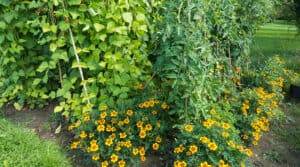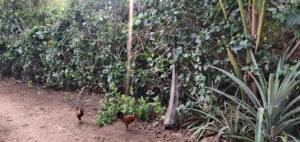Slow it, Spread it, Sink it, Store it
Swales are often featured in permaculture designs around the world. But if you are unfamiliar with this concept then understanding them may seem quite a challenge at first.
In this guide, as a permaculture designer, I will aim to explain this concept. We’ll cover what swales are, types you may encounter, why swales are used, where they are useful and where they are not. We will then go on to discuss in a little more depth the design of swale systems and how to create them and vegetate the system.
What are Swales?
Swales are water management features often used in permaculture design to slow, spread, sink, store and direct water within a landscape. This is one of the earthworks often used in permaculture systems to manage the movement of water in a garden or on a larger site.
Called ditches in some areas, these are specific channel shapes dug into a landscape that aid in water infiltration, and/or the spread, dispersal or movement of water from one area to another.
When you think about water catchment, rainwater barrels or butts may spring to mind. But water catchment also involves catching and retaining water within soil and plants, within the broader landscape, and not just catching rainwater from roofs or driveways or other paved areas.
Swales are often adopted as part of a sustainable water management strategy for a particular area of land. But it is important to understand their limitations, and to understand that there are different water earthworks that might be appropriate for different sites.
Types of Swale:
There are two different broad types of swales often implemented in permaculture designs: on-contour swales, and diversion swales:
On-Contour Swales
On-contour swales are ditches that run along a level line through a landscape with the soil excavated from this ditch piled to create raised berms along the downhill side.
They follow the contour lines of the topography of the site, so that the base of the swale is at the same elevation along its entire length.
Typically around three times as wide as they are deep, these channels catch rainfall, and groundwater flowing from higher up a slope, and keep it around for longer so that water can seep into the soil on the downhill side of the channel.
Over time, the water infiltrated into the soil from an on-contour swale creates a plume of moisture reaching downhill below the ground, providing water naturally for the plants growing on the berm and down-slope from this area.
Diversion Swales
Diversion swales is the name given to different channels through a landscape, that gently move water rather than keeping it around to hydrate the soil of the down-slope area.
These swales are not dug so that the base is at the same elevation along their entire length, but rather dug so that one end is lower than the other.
Water passes downwards along these swales, slowly infiltrating along the length of the channel, but also directing excess water to an area where it is required, or to a pond, reservoir or rain garden where it won’t cause erosion or flooding issues.
There are a few different types of diversion ditches or diversion swales that might be used. In permaculture systems, two key concepts are vegetated swales, or bioswales, and French drains.
Bioswales are swales or ditches or channels on a slight slope, that are planted along their length with plants that can cope with a water deluge. Check dams might also be used along a diversion swale to further slow the progress of water along it.
In high water table or high rainfall areas, infiltration of more water into the landscape in a particular area might not be desired.
In such a situation, French drains take ground water and surface water away from a particular location and take it to another area such as a pond, reservoir or rain garden at the downhill end. Other swales are about keeping water around, while this solution is about directly high levels of water away from one location and directing that excess water to another.
These are ditches or channels with a slight downhill slope filled with gravel, sometimes with roofing tiles, or perforated pipe within them. Water seeps from the surrounding soil into these and is carried through to another area.
We have such drainage channels under our barn conversion kitchen, and running around the outside of our stone walls, through our back garden that can get muddy in winter, to a wildlife pond. Since where I live, we deal less with water shortage and more with excess water – especially in winter.
Why Swales are Used
In understanding swales, the first and most important thing to understand is how water naturally moves within a landscape. While it may sound obvious, the first natural principle to understand is that water flows downhill, taking the path of least resistance.
Another important area to explore when thinking about the use of swales and water management is how not only how water flows, but how it is slowed and stored within a landscape. We need to understand water, and its interactions with soil and with plants.
In permaculture, one of our key goals is to make sure that we are making the most of all the natural freshwater resources available to us in the climate and environment where we live. The solutions that can be found to meet that goal are certainly not one-size-fits-all.
But in a range of environments, swales can be used to catch and store more water within a landscape, in soil and in plants, rather than allowing it to drain away. They are also used to reduce surface water pressures that increase soil degradation through runoff and erosion on slope.
On-contour swales can facilitate the infiltration of rainfall and groundwater into the soil, helping us to catch and store more water in soil, and in plants.
In areas with a higher water table, where too much water can be more of an issue than too little, diversion swales can also be used to move water slowly to where it is required, and away from areas where it may cause issues within the landscape, or to human habitation.
Where Swales are Used
On-contour swales are used on more gentle slope in both wetter and drier climate zones. In some instances, they help to make the most of even very limited water resources. In others, they help a land manager or gardener to deal with excessive water that would otherwise rush down a slope causing runoff and soil erosion, allowing that rainfall to instead soak more effectively into the land.
Diversion swales tend to be utilised where natural rainfall is higher, and the capacity of the soil on a site to store water may be reached in some areas. This necessitates directing water slowly from one area to another for storage or use, to that the natural resource is harnessed to the fullest and problems do not arise due to excess rainfall.
Where Not to Use Swales
But though swales of both types can be very useful in water management and landscape design, it is important to understand that there are times when swales may not be the best solution.
On-contour swales may not always be ideal for sites with higher rainfall and a high water table, since increasing the saturation of the soil with water above a certain point is not a good idea. Swales used in the wrong places can potentially de-stabilize slopes, and cause landslips or other catastrophic issues to arise.
Another important thing to understand is that while on-contour swales can be extremely beneficial on less extreme slopes, they are not the right solution for slopes greater than around 15%.(That is, in other words, a slope that drops no more than around 1m over every 7m or so of horizontal distance.) On steeper slopes, other solutions like terracing are better employed and swales can potentially cause landslip issues or other problems.
The implementation of swales is something that has to be carefully considered. And swales should never be created without first going through a careful and thorough design process.
Designing a Swale System
Where swales are used, it is of course very important to plan and design these correctly for a specific site.
You cannot simply copy a swale system from a different site and expect it to work similarly on your own. As in all permaculture design, observation and analysis of a specific site are crucial before any design work begins.
What You Need to Know
In order to design a swale system, and to understand whether swales are the right option and if so, which swales to use, there are several key pieces of information that you need to obtain:
- Your climate and the rainfall expected in your area throughout the year.
- How much rainfall can be expected on the site in a single large precipitation event.
- The topography of the site, and the degree of slope in the area where you are considering implementing a swale system.
- The length and breadth of the sloped area of the site available for earthworks.
- Soil characteristics and existing groundcover that will determine the amount of runoff from a slope.
As you can tell from the above, calculation of an effective and safe swale system takes quite a lot of work, and involves a certain degree of complexity that can make it challenging for the lay-person to determine on their own. Often, a degree of experimentation is required to determine the optimal solution for a specific site.
Swales can vary a lot in their positioning, number and size, depending on the specifics of a particular situation. On a small, domestic site, 2-3 very small swales might be placed, while a greater number of much larger swales, and a far more complex swale system might be implemented on a larger property or at landscape scale.
Sizing Swales
On-contour swales should be sized to be able to deal with the rainfall and water catchment of the site. Typically, we measure the capacity of a swale using the area its cross-section. This helps us to determine the maximum amount of water that a swale can hold for infiltration.
Once we determine the required cross-section of a swale, we can work out how wide and how deep it needs to be. An on-contour swale, as mentioned above, should typically be around three times as wide as it is deep. It is best to make these swales as long as they can be, to maximise the water catchment.
When deciding how large a swale has to be, we need to think about rainfall, and catchment area above the swale. If in doubt, it is generally best to size swales a little larger than they need to be, rather than too small, to build in some resiliency.
How Many Swales?
Of course, side by side with considering how large swales should be, we also need to think carefully about how many swales to place.
When determining this, we need to think holistically about the site layout as well as considering our needs, and how much water we need to catch, slow and infiltrate within a given area.
By playing around with the size of the area and amount of water, we can slowly come to a sensible plan that gets close to achieving our infiltration and water management goals, with a sensible size and number of swales.
Positioning Swales
Another important part of the puzzle is working out where to position each of the swales within a swale system. Swale spacing is a complex question that does not always have a clear and definitive answer.
However, as a general rule, to capture the maximum amount of water on a property (sometimes, though not always the goal) since groundwater flows downhill, leaving the top half of a slope drier than the bottom, we will place swales somewhat closer near the top of a slope, and have fewer, more widely spaced, towards the lower end.
Remember, however, that swale systems that work well in one specific location won’t be the right solution in another. So when thinking about size, number and positioning of swales, it is important to take the individual site and circumstances into account.
How to Build a Swale
When creating swales of any type, and at whatever scale, caution is key. Make sure that you always have firm foundations based in scientific analysis and rooted in the specifics of your own individual site.
When creating on-contour or diversion swales, an understanding of the topography of the site and determining the contours and slope is the first step. To make sure that an on-contour swale is level along its course, or to make sure you have the right degree of slope for a diversion swale, you can use sophisticated equipment, or something more simple like an A-frame level.
Once you have marked out the course of your swale or swales, they can be dug by hand, with a spade, or with machinery on a larger site. The excavated soil will be piled to create the berm mound on the downhill side with an on-contour swale. (Topsoil excavated to create a French drain might be utilised in raised beds, or elsewhere on your property.)
It is also important to create spillways so that if swales do fill entirely, excess water can drain downhill to another swale, or to ponds, reservoirs, rain gardens or other features down-slope. Remember, swales are only ever part of a water management system and not an entire solution on their own.
Planting on or in Swales
With on-contour swales and vegetated swales, it is important to plant up the system right away. It is important to get living roots into the soil as soon as possible.
With on-contour swales, it is typically the berm that is planted with trees, shrubs, and deeper-rooted perennials as well as shallower rooted groundcover plants to stabilize the soil at all layers.
Planting within the swale might sometimes take place in dryland systems, while in other situations, organic mulch might sometimes be used to fill the base of the swales and aid in water infiltration.
With vegetated swales, the gently sloping channels are planted up with grasses or other hardy species that protect the soil and aid with infiltration, serving to slow the progress of water down the channel, allowing it to soak into the soil.
Swales are sometimes considered an essential for a permaculture design. But remember, these are just one water management solution in your arsenal, and they may not be the correct solution for every site. But where they are beneficial, and where they are implemented correctly, they can be a wonderful way to help you manage water effectively on your property.







